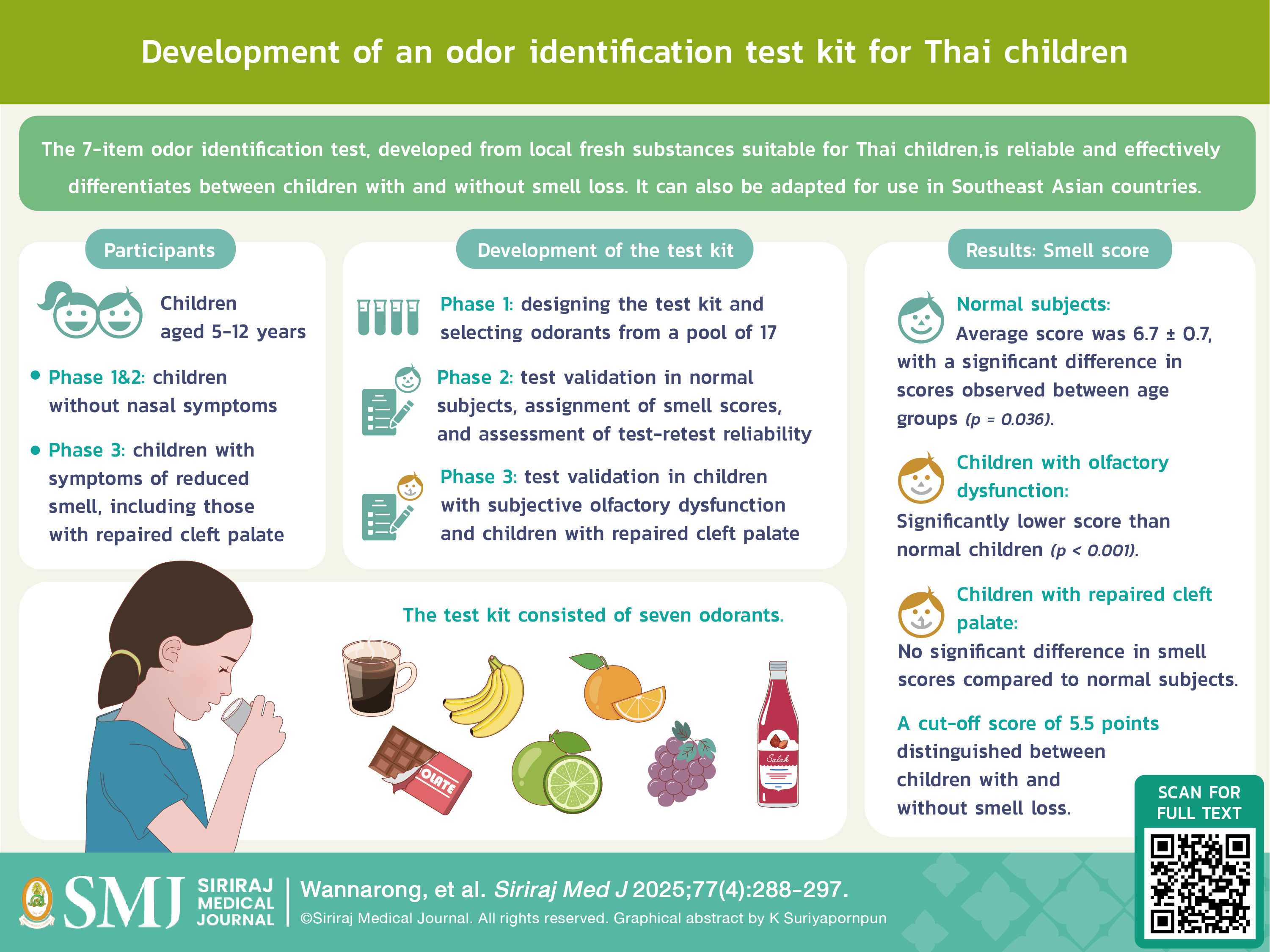Development of an Odor Identification Test Kit for Thai Children
Odor Test for Children
DOI:
https://doi.org/10.33192/smj.v77i4.272527Keywords:
Smell loss, smell test, odor identification test, olfactory dysfunctionAbstract
Objective: To develop and validate an odor identification test kit for Thai children that can be adapted for use in Southeast Asian countries.
Materials and Methods: The test kit was developed in three phases, using local fresh substances. Phase 1 involved designing the test kit and selecting odorants from a pool of 17. Phase 2 focused on test validation in normal subjects, assignment of smell scores, and assessment of test-retest reliability. Phase 3 validated the test in children with subjective olfactory dysfunction and children with repaired cleft palate. Cut-off scores were determined using receiver operating curve analysis.
Results: The participants were children aged 5-12 years. Sample sizes in Phases 1, 2, and 3 were 53, 31, and 36, respectively. Seven odorants that met the selection criteria were chosen. The average score for normal subjects was 6.7 (SD 0.7), with a significant difference between age groups (p = 0.036). Children with olfactory dysfunction had an average score of 3.8 (SD 1.6), significantly lower than normal children (p < 0.001). Children with repaired cleft palate showed no significant difference in smell scores compared to normal subjects. A cut-off score of 5.5 points was used to distinguish between normal and abnormal olfactory function, with an area under the curve of 0.928.
Conclusion: Children aged 5-12 years were able to complete the 7-item odor identification test developed from local fresh substances. The test kit demonstrated good reliability and effectively distinguished between children with and without smell loss, using a cut-off score of 5.5.
References
Pinkaew B, Assanasen P, Michel O, Talek K, Phonmanee T, Jeerapa Kerdnoppakhun J x. Impact Assessment of Smell and Taste Disorders on Quality of Life in Thais Using the SF-36 Health Survey (Thai version). Siriraj Med J. 2019;71(2):102-9.
Li W, Luxenberg E, Parrish T, Gottfried JA. Learning to smell the roses: experience-dependent neural plasticity in human piriform and orbitofrontal cortices. Neuron. 2006;52(6):1097-108.
Whitcroft KL, Altundag A, Balungwe P, Boscolo-Rizzo P, Douglas R, Bnecilla MLB, et al. Position paper on olfactory dysfunction: 2023. Rhinology. 2023;61(33):1-108.
Ottaviano G, Cantone E, D’Errico A, Salvalaggio A, Citton V, Scarpa B, et al. Sniffin’ Sticks and olfactory system imaging in patients with Kallmann syndrome. Int Forum Allergy Rhinol. 2015;5(9):855-61.
Cameron EL. Olfactory perception in children. World J Otorhinolaryngol Head Neck Surg. 2018;4(1):57-66.
Schriever VA, Agosin E, Altundag A, Avni H, Van HC, Cornejo C, et al. Development of an International Odor Identification Test for Children: The Universal Sniff Test. J Pediatr. 2018;198:265-272.e3.
Cameron EL, Doty RL. Odor identification testing in children and young adults using the smell wheel. Int J Pediatr Otorhinolaryngol. 2013;77(3):346-50.
Fornazieri MA, Ebara LK, Araujo RG, Lima JVF, Favareto FB, Pinna FR, et al. Adaptation of the Pediatric Smell Wheel (TM) to evaluate olfactory function in Brazilian children. Braz J Otorhinolaryngol. 2022;88(Suppl 5):S47-S51.
Ayabe-Kanamura S, Schicker I, Laska M, Hudson R, Distel H, Kobayakawa T, et al. Differences in perception of everyday odors: a Japanese-German cross-cultural study. Chem Senses. 1998;23(1):31-8.
Schriever VA, Zscheile L, Gellrich J, Hummel T. Odor identification performance in children aged 3–6 years. Pediatr Res. 2021;89(5):1304-9.
Dalton P, Doty RL, Murphy C, Frank R, Hoffman HJ, Maute C, et al. Olfactory assessment using the NIH Toolbox. Neurology. 2013;80(11 Suppl 3):S32-S36.
Murphy C, Anderson JA, Markison S. Psychophysical Assessment of Chemosensory Disorders in Clinical Populations. In: Kurihara K, Suzuki N, Ogawa H, eds. Olfaction and Taste XI. Springer Japan; 1994.p.609-13.
Schriever VA, Mori E, Petters W, Boerner C, Smitka M, Hummel T. The “Sniffin’ Kids” test--a 14-item odor identification test for children. PLoS One. 2014;9(6):e101086.
Smith WM, Davidson TM, Murphy C. Toxin-induced chemosensory dysfunction: a case series and review. Am J Rhinol Allergy. 2009;23(6):578-81.
Agin K, Hassanian-Moghaddam H, Shadnia S, Rahimi HR. Characteristic manifestations of acute paint thinner-intoxicated children. Environ Toxicol Pharmacol. 2016;45:15-9.
Milton LA, White AR. The potential impact of bushfire smoke on brain health. Neurochem Int. 2020;139:104796.
Filipsson AF. Short term inhalation exposure to turpentine: toxicokinetics and acute effects in men. Occup Environ Med. 1996;53(2):100-5.
Gellrich J, Sparing-Paschke LM, Thieme T, Schwabe K, Dworschak A, Hummel T, et al. Normative data for olfactory threshold and odor identification in children and adolescents. Int J Pediatr Otorhinolaryngol. 2019;123:5-9.
Dżaman K, Zielnik-Jurkiewicz B, Jurkiewicz D, Molińska-Glura M. Test for screening olfactory function in children. Int J Pediatr Otorhinolaryngol. 2013;77(3):418-423.
Grossmann N, Brin I, Aizenbud D, Sichel JY, Gross-Isseroff R, Steiner J. Nasal airflow and olfactory function after the repair of cleft palate (with and without cleft lip). Oral Surg Oral Med Oral Pathol Oral Radiol Endod. 2005;100(5):539-44.
Doty R, Marcus A, Lee W. Development of the 12-item Cross-Cultural Smell Identification Test (CC-SIT). Laryngoscope. 1996;106(3 Pt 1):353-6.
Bastos LOD, Guerreiro MM, Lees AJ, Warner TT, Silveira-Moriyama L. Effects of Age and Cognition on a Cross-Cultural Paediatric Adaptation of the Sniffin’ Sticks Identification Test. PLoS One. 2015;10(8):e0131641.
Cavazzana A, Wesarg C, Schriever VA, Hummel T, Lundstrom JN, Parma V. A Cross-Cultural Adaptation of the Sniffin’ Sticks Olfactory Identification Test for US children. Chem Senses. 2017;42(2):133-40.
Dalton P, Mennella JA, Maute C, Castor SM, Silva-Garcia A, Slotkin J, et al. Development of a test to evaluate olfactory function in a pediatric population. Laryngoscope. 2011;121(9):1843-50.
Chen D, Zhang Y, Zhao J, Liu L, Zhao L. Research Progress on Physical Preservation Technology of Fresh-Cut Fruits and Vegetables. Horticulturae. 2024;10(10):1098.
Mani M, Moren S, Thorvardsson O, Jakobsson O, Skoog V, Holmstrom M. EDITOR’S CHOICE: objective assessment of the nasal airway in unilateral cleft lip and palate--a long-term study. Cleft Palate Craniofac J. 2010;47(3):217-24.
Warren DW, Drake AF. Cleft nose. Form and function. Clin Plast Surg. 1993;20(4):769-79.
DeVere R. Disorders of Taste and Smell. Continuum (Minneap Minn). 2017;23(2, Selected Topics in Outpatient Neurology):421-46.
Welge-Lüssen A, Hummel T. Management of Smell and Taste Disorders : A Practical Guide for Clinicians. Georg Thieme Verlag; 2014.
Monnery-Patris S, Rouby C, Nicklaus S, Issanchou S. Development of olfactory ability in children: sensitivity and identification. Dev Psychobiol. 2009;51(3):268-76.
Gellrich J, Sparing-Paschke LM, Hummel T, Schriever VA. The Influence of Cognitive Parameters on Olfactory Assessment in Healthy Children and Adolescents. Chem Senses. 2021;46.
Mariño-Sánchez F, Valls-Mateus M, Fragola C, Los Santos G, Aguirre A, Alonso J, et al. Pediatric Barcelona Olfactory Test -6 (pBOT-6): Validation of a Combined Odor Identification and Threshold Screening Test in Healthy Spanish Children and Adolescents. J Investig Allergol Clin Immunol. 2020;30(6):439-47.
Krantz EM, Schubert CR, Dalton DS, Zhong W, Huang GH, Klein BEK, et al. Test-retest reliability of the San Diego Odor Identification Test and comparison with the brief smell identification test. Chem Senses. 2009;34(5):435-40.
Ciofalo A, de Vincentiis M, Zambetti G, Altissimi G, Fusconi M, Greco A, et al. Olfactory dysfunction in acute rhinosinusitis: intranasal sodium hyaluronate as adjuvant treatment. Eur Arch Otorhinolaryngol. 2017;274(2):803-8.
Dalton P. Olfaction and anosmia in rhinosinusitis. Curr Allergy Asthma Rep. 2004;4(3):230-6.
Dodé C, Hardelin J-P. Kallmann syndrome. Eur J Hum Genet. 2009;17(2):139-46.
Klingmuller D, Dewes W, Krahe T, Brecht G, Schweikert HU. Magnetic resonance imaging of the brain in patients with anosmia and hypothalamic hypogonadism (Kallmann’s syndrome). J Clin Endocrinol Metab. 1987;65(3):581-4.
Roosenboom J, Hermans R, Lammens F, Samain JL, Devriendt K, Poorten VV, et al. Olfactory function in patients with nonsyndromic orofacial clefts and their unaffected relatives. Am J Med Genet A. 2018;176(11):2375-81.

Published
How to Cite
Issue
Section
Categories
License
Copyright (c) 2025 Siriraj Medical Journal

This work is licensed under a Creative Commons Attribution-NonCommercial-NoDerivatives 4.0 International License.
Authors who publish with this journal agree to the following conditions:
Copyright Transfer
In submitting a manuscript, the authors acknowledge that the work will become the copyrighted property of Siriraj Medical Journal upon publication.
License
Articles are licensed under a Creative Commons Attribution-NonCommercial-NoDerivatives 4.0 International License (CC BY-NC-ND 4.0). This license allows for the sharing of the work for non-commercial purposes with proper attribution to the authors and the journal. However, it does not permit modifications or the creation of derivative works.
Sharing and Access
Authors are encouraged to share their article on their personal or institutional websites and through other non-commercial platforms. Doing so can increase readership and citations.














